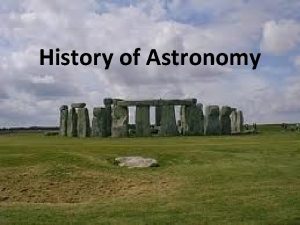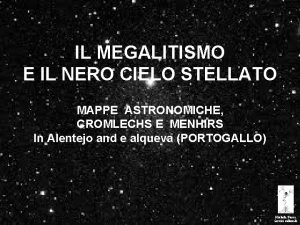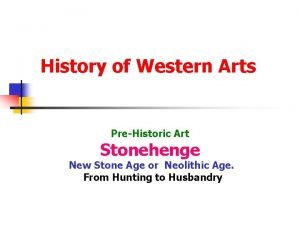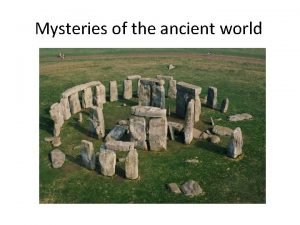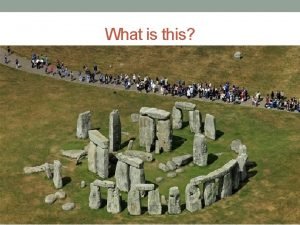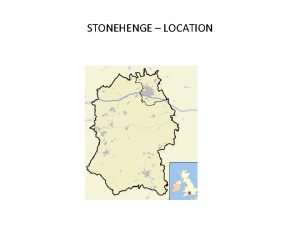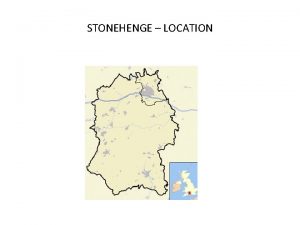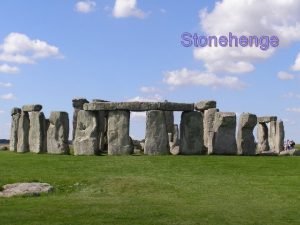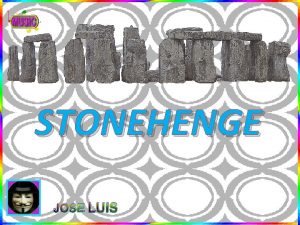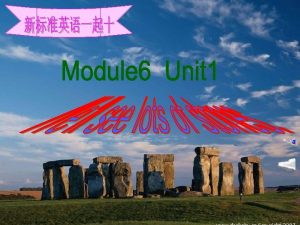Stonehenge Stonehenge 1 After Cleal et al The












- Slides: 12


Stonehenge

Stonehenge 1. After Cleal et al. Κάντε κλικ εδώ για την The firstεπεξεργασία monument consisted of a circular της μορφής των bank andκειμένων ditch enclosure made of Late διάρθρωσης • Cretaceous(Santonian Age). Δεύτερο επίπεδο Seaford Chalk, διάρθρωσης , measuring about 110 metres • (360 ft) in diameter. • • Τρίτο επίπεδο διάρθρωσης A large entrance to the north east and a smaller one to the south. Τέταρτο επίπεδο διάρθρωσης The builders placed the bones of deer and oxen in the bottom of the ditch, Πέμπτο as well as some worked flint tools. • • επίπεδο διάρθρω This first stage is dated to aroundσης 3100 BC, after which the ditch began to silt up Έκτο naturally. επίπεδο διάρθρω Within the outer edge of the enclosed area is σης a circle of 56 pits, each about a metre (3'3") Έβδομο in diameter(13), known as the Aubrey holes after John Aubrey, the 17 th-επίπεδο διάρθρω century antiquarian who was thought to have first identified them. σης

Stonehenge 2 (ca. 3000 BC) • Evidence of the second phase is no longer visible. timbers Κάντε κλικFurther εδώ γιαstanding την wereεπεξεργασία placed at theτης northeast μορφήςentrance, των and aκειμένων parallel alignment of posts ran διάρθρωσης inwards from the southern entrance. The bank was purposely reduced in Δεύτερο επίπεδο height andδιάρθρωσης the ditch continued to silt up. At least twenty-five of the Aubrey Τρίτο επίπεδο Holes are known to have contained διάρθρωσης later, intrusive, cremation burials dating to the two centuries after the Τέταρτο monument's inception. επίπεδο It seems that whatever the holes' initial function, it διάρθρωσης changed to become a funerary one Πέμπτο during Phase 2. Stonehenge is επίπεδοas therefore interpreted as functioning διάρθρω an enclosed cremation cemetery at this σης time, the earliest known cremation Έκτο cemetery in the British Isles. επίπεδο διάρθρω σης Έβδομο επίπεδο διάρθρω σης

2600 BC) • Archaeological excavation has indicated that around 2600 BC, the builders abandoned timber in favour of stone Κάντε κλικ εδώand γιαdug τηνtwo concentric arrays of holes in the centre of the επεξεργασία της μορφής των site. The holes held up to 80 standing stones (shownκειμένων blue on theδιάρθρωσης plan), only 43 of which can be traced today. Δεύτερο επίπεδο The bluestonesδιάρθρωσης , were thought for much of the • 20 th century to have been transported by humans from the Preseli Hills, επίπεδο 150 miles Τρίτο (240 km) away in modern-day Pembrokeshire in διάρθρωσης Wales. Other standing stones may well have been small sarsens, used later as lintels. The Τέταρτο stones, which weighed about four tons, επίπεδο consisted mostly of spotted Ordovician dolerite διάρθρωσης but included examples of rhyolite, tuff and volcanic and calcareousash; Πέμπτο in total around 20 different rock types are επίπεδο represented. The Heelstone (5), a tertiary διάρθρω sandstone, may also have been erected outside the north-eastern entrance during this period. It σης was accompanied by a second stone, which is Έκτο no longer visible. Two, or possibly three, large portal stones were set up just inside the επίπεδο north-eastern entrance, of which onlyδιάρθρω one, the fallen Slaughter Stone (4), 4. 9 metres (16 ft) σης long, now remains. Έβδομο επίπεδο διάρθρω σης

Stonehenge 3 II (2600 BC to 2400 BC) • During the next major phase of activity, 30 enormous Oligocene-Miocene sarsen stones (shown grey on the plan) were brought to the site. They may have come from a quarry, around 25 miles (40 km) north of Stonehenge on the Marlborough Downs, or they may have been collected from a "litter" of sarsens on the chalk downs, closer to hand. The stones were dressed and fashioned with mortise and tenon joints before 30 were erected as a 33 metres (108 ft) diameter circle of standing stones, with a ring of 30 lintel stones resting on top. Each had clearly been worked with the final visual effect in mind the orthostats widen slightly towards the top in order that their perspective remains constant when viewed from the ground to continue the circular appearance of the earlier monument. The average thickness of the stones is 1. 1 metres (3 ft 7 in) and the average distance between them is 1 metre (3 ft 3 in). A total of 75 stones would have been needed to complete the circle (60 stones) and the trilithon horseshoe (15 stones). Within this circle stood five trilithons of dressed sarsen stone arranged in a horseshoe shape 13. 7 metres (45 ft) across with its open end facing north east. This ambitious phase has been radiocarbon dated to between 2600 and 2400 BC, [14] slightly earlier than the Stonehenge Archer, discovered in the outer ditch of the monument in 1978, and the two sets of burials, known as the Amesbury Archer and the Boscombe Bowmen, discovered 3 miles (4. 8 km) to the west.

Stonehenge 3 IV (2280 BC to 1930 BC) This phase saw further rearrangement of the bluestones. They were arranged in a circle between the two rings of sarsens and in an oval at the centre of the inner ring. All the stones formed well-spaced uprights without any of the linking lintels inferred in Stonehenge 3 III. The Altar Stone may have been moved within the oval at this time and re-erected vertically. Although this would seem the most impressive phase of work, Stonehenge 3 IV was rather shabbily built compared to its immediate predecessors, as the newly re-installed bluestones were not well-founded and began to fall over. However, only minor changes were made after this phase.

Stonehenge 3 V (1930 BC to 1600 BC) • Soon afterwards, the north eastern section of the Phase 3 IV bluestone circle was removed, creating a horseshoe-shaped setting (the Bluestone Horseshoe) which mirrored the shape of the central sarsen Trilithons. This phase is contemporary with the Seahenge site in Norfolk. The last known construction at Stonehenge was about 1600 BC (see 'Y and Z Holes'), and the last usage of it was probably during the Iron Age. Roman coins and medieval artefacts have all been found in or around the monument but it is unknown if the monument was in continuous use throughout prehistory and beyond, or exactly how it would have been used. Notable is the massive Iron Age hillfort. Vespasian's Camp built alongside the Avenue near the Avon. A decapitated 7 th century Saxon man was excavated from Stonehenge in 1923. [16] The site was known to scholars during the Middle Ages and since then it has been studied and adopted by numerous groups.

16 th century to present Stonehenge has changed ownership Κάντε κλικ εδώ για την several times sinceεπεξεργασία acquired Amesbury Abbeyτων and its της μορφής surrounding lands. In διάρθρωσης 1540 Henry gave the κειμένων estate to the Earl of Hertford. It subsequently passed to Lord Carletonand then the Marquis of Δεύτερο επίπεδο Queensbury. Theδιάρθρωσης Antrobus family of Cheshire bought the estate in 1824. During World War I an aerodrome had been built o. King Henry VIIIn Τρίτο επίπεδο the downs just to the west of the circle and, in διάρθρωσης the dry valley at Stonehenge Bottom, a main Τέταρτο road junction had been built, along with several επίπεδο cottages and a cafe. In the late 1920 s a nationδιάρθρωσης wide appeal was launched to save Stonehenge from the encroachment of the modern Πέμπτο buildings that had begun to appear around it. επίπεδο By 1928 the land around the monument had διάρθρω been purchased with the appeal donations, and σης given to the National Trust in order to preserve Έκτοthe it the buildings were removed (although επίπεδο roads were not). διάρθρω σης Έβδομο επίπεδο διάρθρω σης



 After me after me after me
After me after me after me John 14:1
John 14:1 Mars jupiter and saturn show retrograde motion because
Mars jupiter and saturn show retrograde motion because Cielo stellato nero
Cielo stellato nero Parys conference venues
Parys conference venues Humankind stonehenge
Humankind stonehenge Stonehenge art history
Stonehenge art history When was stonehenge built
When was stonehenge built Stonehenge and easter island
Stonehenge and easter island Reading to stonehenge
Reading to stonehenge Characteristics of stonehenge
Characteristics of stonehenge Spanish althabet
Spanish althabet Stonehenge makett
Stonehenge makett


